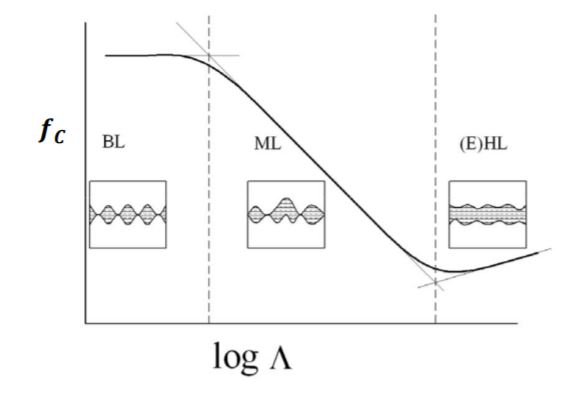Boundary Lubrication
What is Boundary Lubrication?
Boundary lubrication describes situations where the applied load is primarily supported by contacting solid asperities, rather than a liquid lubricant. The boundary lubrication regime acts when the lambda ratio (the ratio of the lubricant film thickness to the composite surface roughness) is less than unity [1]. This is more prevalent for components with rough surfaces, operating at high pressure and low sliding velocity.
Over the last few decades, the main strategy from lubricant formulators to improve the energy efficiency of internal combustion engines has been to lower lubricant viscosity to reduce hydrodynamic friction losses. However, this means that more components operate for significant periods of time in the boundary lubrication regime. This means that controlling friction and wear in the boundary regime is becoming increasingly important [1]. Two main strategies exist to reducing boundary friction and wear; lubricant additives and surface coatings. Spikes has provided detailed reviews of the main lubricant additives used to control boundary friction [2] and wear [3], while Erdemir has reviewed the main types of surface coatings [4]. Synergistic combinations of specific types of additives and coatings which give very low friction and wear have also been identified [5].
Organic Friction Modifiers (OFMs)
The term ‘boundary lubrication’ was coined by Hardy and Doubleday in 1922 [6]. They studied the friction of surfactant molecules, which contain polar headgroups and nonpolar tailgroups, on glass and steel surfaces. They showed that fatty acids and fatty alcohols produced a progressively lower friction on glass and steel surfaces as their chain length was increased. They proposed that friction reduction was produced by the adsorption of vertically oriented, single monolayers of these surfactants on each surface, which separated the rubbing surfaces [2]. This view of boundary lubrication, shown in Figure 1, has become known as the Hardy model. This model remains the most widely accepted view of the friction reduction mechanism of organic friction modifier (OFM) additives dissolved in hydrocarbon solvents lubricating steel surfaces.

Figure 1. The Hardy model for boundary lubrication.
In 1940, Bowden and Leben [7] showed that single monolayers formed on steel surfaces using the Langmuir-Blodgett (L-B) method [8] initially gave very similar friction coefficients to fatty acids dissolved in hydrocarbon solvents. However, the low friction of the L-B film was only maintained for 2-3 passes and only became more durable when multilayers, rather than monolayers, were deposited on the surfaces [7]. This indicated the importance of there being a supply of fatty acid molecules to repair the monolayer which was damaged during rubbing [2].
In 1982, Briscoe and Evans [9] showed that boundary friction of fatty acid L-B films deposited on mica surfaces increased linearly with log(sliding velocity). Campen et al. [10] showed the same behaviour for a range of OFMs with linear saturated alkyl tails; however, OFMs with kinked Z-unsaturated tails gave far higher friction coefficients which showed a weaker velocity dependence. In 2016, Wood et al. [11] showed using polarised neutron reflectometry (PNR) that OFMs with saturated tails form much more densely-packed monolayers on iron oxide surfaces from hydrocarbon solvents compared to those with Z-unsaturated tails. Molecular dynamics simulations by Ewen et al. [12] suggested that increased interdigitation for the lower surface coverage films formed by OFMs with Z-unsaturated tails was the cause of the higher macroscopic friction compared to OFMs with saturated tails. Recent quartz crystal microbalance, ellipsometry, and macroscale tribology experiments have confirmed that OFMs which form lower coverage monolayers initially give higher friction [13].

Figure 2. Schematic showing difference in surface coverage for OFMs with saturated (left) and Z-unsaturated (right) tails. Adapted from Ref. [11].
It has also been suggested that multilayers play an important role in the friction reduction mechanism of OFMs [14]. Although Bowden and Leben [7] showed that L-B multilayers help to replenish damaged monolayers, there has not been any experimental support to suggest that multilayers play a more direct role in the frictional response of OFM films formed from base oil solution.
Although fatty acids have been used in the majority of published research on OFMs, they are no longer employed commercially due to their acidic nature. This can corrode surfaces and neutralise overbased detergents. Therefore, fatty alcohols, amines, amides, and esters, with tails of between 12-20 carbon atoms, are now usually employed [2].
Other boundary additives
In addition to OFMs, many other types of additive have been developed to reduce friction and wear in the boundary lubrication regime. For example, zinc dialkyldithophosphate (ZDDP) is the principal antiwear additive in engine lubricants [3]. ZDDP adsorbs on steel surfaces and decomposes to form relatively thick protective tribofilms. The film close to the steel substrate consists mostly of iron sulphide while the outer region is mostly zinc/iron phosphate [3].
Organomolybdenum additives, such as molybdenum dialkyldithiophosphate (MoDDP) and molybdenum dialkyldithiocarbamate (MoDTC), were first introduced in the 1950s [2]. They decompose on rubbing surfaces to form thin lamellar MoS2 films, which can significantly reduce friction.
References
- Taylor, R.I., Morgan, N., Mainwaring, R., Davenport, T.: How much mixed/boundary friction is there in an engine - and where is it? Proc. Inst. Mech. Eng. Part J J. Eng. Tribol. (2019). doi:10.1177/1350650119875316
- Spikes, H.: Friction Modifier Additives. Tribol. Lett. 60, 5 (2015). doi:10.1007/s11249-015-0589-z
- Spikes, H.: The history and mechanisms of ZDDP. Tribol. Lett. 17, 469–489 (2004). doi:10.1023/B:TRIL.0000044495.26882.b5
- Erdemir, A.: Review of engineered tribological interfaces for improved boundary lubrication. Tribol. Int. 38, 249–256 (2005). doi:10.1016/j.triboint.2004.08.008
- Neville, A., Morina, A., Haque, T., Voong, Q.: Compatibility between tribological surfaces and lubricant additives - How friction and wear reduction can be controlled by surface/lube synergies. Tribol. Int. 40, 1680–1695 (2007). doi:10.1016/j.triboint.2007.01.019
- Hardy, W.B., Doubleday, I.: Boundary lubrication-The paraffin series. Proc. R. Soc. London, Ser. A. 100, 550–557 (1922). doi:10.1098/rspa.1983.0054
- Bowden, F., Leben, L.: The Friction of Lubricated Metals. Philos. Trans. R. Soc. London, Ser. A. 239, 1–27 (1940). doi:10.1098/rsta.1940.0007
- Blodgett, K.B.: Films Built by Depositing Successive Monomolecular Layers on a Solid Surface. J. Am. Chem. Soc. 57, 1007–1022 (1935). doi:10.1021/ja01309a011
- Briscoe, B.J., Evans, D.C.B.: The shear properties of Langmuir-Blodgett layers. Proc. R. Soc. London, Ser. A. 380, 389–407 (1982). doi:10.1098/rspa.1982.0048
- Campen, S., Green, J., Lamb, G., Atkinson, D., Spikes, H.: On the Increase in Boundary Friction with Sliding Speed. Tribol. Lett. 48, 237–248 (2012). doi:10.1007/s11249-012-0019-4
- Wood, M.H., Casford, M.T., Steitz, R., Zarbakhsh, A., Welbourn, R.J.L., Clarke, S.M.: Comparative Adsorption of Saturated and Unsaturated Fatty Acids at the Iron Oxide/Oil Interface. Langmuir. 32, 534–540 (2016). doi:10.1021/acs.langmuir.5b04435
- Ewen, J.P., Gattinoni, C., Morgan, N., Spikes, H., Dini, D.: Nonequilibrium Molecular Dynamics Simulations of Organic Friction Modifiers Adsorbed on Iron Oxide Surfaces. Langmuir. 32, 4450–4463 (2016). doi:10.1021/acs.langmuir.6b00586
- Fry, B.M., Moody, G., Spikes, H.A., Wong, J.S.S.: Adsorption of Organic Friction Modifier Additives. Langmuir. 36, 1147–1155 (2020). doi:10.1021/acs.langmuir.9b03668
- Allen, C., Drauglis, E.: Boundary layer lubrication: Monolayer or multilayer. Wear. 14, 369–384 (1969). doi:10.1016/0043-1648(69)90017-9



Be the first to comment